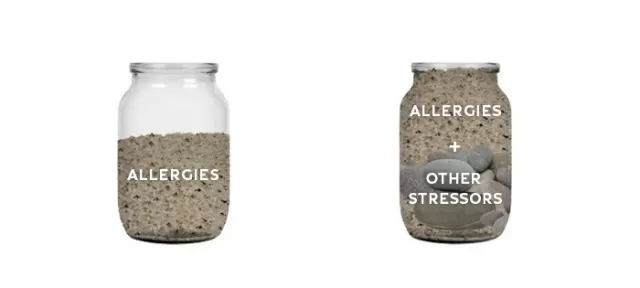-
ALLERGY IQ
Allergies and Health -

Children & Inhalant Allergies Allergies are a chronic disorder that starts early in life. It is one of the most common health conditions that affects one out of three children in the U.S. -

Oral Allergy Syndrome is Not Food Allergy Oral allergy syndrome (OAS) is often confused with food allergies but is not the same thing and is more common than people realize. -

Allergies & Poor Sleep Sleep is a huge factor in health and wellbeing. If your quality of sleep is affected by allergies, know that there are solutions. -

Hay Fever (Allergic Rhinitis) Unlike the common cold, hay fever is not caused by a virus. Instead, it’s caused by an allergic response to indoor/outdoor allergens like pollens, mold, mites.
-

How Allergies and Asthma are Related People who suffer from allergies can develop asthma and those with asthma can suffer from allergies. Both conditions are closely related. -

Allergy Load Find out why chronic allergic disease progresses with age, learn about Total Allergy Load, stressors, and why you don't want to delay allergy treatment.
Treating Allergies -

Managing Your Allergies Allergies are a serious burden on your immune system, not just runny nose, sneezing, and itchy eyes. Learn how to safely treat allergies for full-body health. -

Testing For Allergies: Is It Necessary? Allergy testing is a necessary step in treating symptoms of allergic rhinitis. Skin and blood tests can find the source and ideal treatment for your symptoms. -

Nasal Steroid Sprays Due to their high efficacy and safety, nasal steroid sprays are considered the first line of treatment for allergic rhinitis and other nasal conditions. -

Nasal Obstruction, Inhalant Allergies, and Turbinate Reduction Inhalant allergies can cause nasal obstruction and enlarged turbinates. Learn about the causes and treatment options for your chronic congestion.
-
- ALLERGY EXPLORER
- ALLERGY QUIZ
- SEARCH
- ACCOUNT
Total Allergy Load
And the Progression of Allergic Disease
Why is it that you have good days and bad days when it comes to your health? Do you notice particular chemicals, allergens, or foods affecting you on certain days, yet other times you're without symptoms? Have you ever wondered why something you are exposed to now creates a reaction when it was previously never an issue?
Our immune system has a certain capacity to handle exposure to allergens, known as the Total Allergy Load. All types of irritants are contributing factors to this load, including allergies to:
- Pollen
- Mold
- Food
- Drug
- Insect stings
- Latex
- Pet dander
- Dust
- And even cockroaches
Picture the capacity of your immune system as a glass jar, like the image below. The sand in the jar represents the Allergy Load.

The pebbles on the bottom of the jar on the right represent the numerous other contributing factors (stressors) that can affect the capacity of the immune system to handle allergies. Factors include not only exposure to allergens but also exposure to:
- Chemical toxins
- Infections
- Hormonal balance
- Emotional stress
- Physical exhaustion
- Nutritional changes
The combination of the Allergy Load and a stack of other stressors is what overwhelms the immune system and makes a person sick. Sometimes a person feels no symptoms for a long time but then experiences what seems like spontaneous symptoms. That’s because the Allery Load fluctuates depending on two elements:
- Exposure can increase based on the season, location, and climate - environmental changes can even lengthen a region’s pollen season.
- Because allergy is a progressive chronic disease, patients experience sensitivity changes and become more prone over time.
The allergy epidemic is gaining momentum. Worldwide, more people are becoming increasingly sensitive to multiple allergens - and exposure to those allergens is escalating as well. As that happens, the symptoms become more apparent and long-lasting, especially with the combination of other prevalent stressors.
Why Don’t I Have Symptoms All The Time?
Everyone has their own unique combination of allergic triggers, and not all of them are obvious. You may be sensitized to several allergen sources, but not enough to trigger symptoms when you are exposed to only one of them. But when you encounter multiple allergens simultaneously, the effects accumulate, and that’s when you may start experiencing symptoms. The immune system focuses on the allergens to which you have the highest sensitivity.

Most people with allergies are allergic to multiple allergens. And for some of these people, symptoms may appear only when they encounter two or more things they’re allergic to at the same time. You could have an allergy to dust mites and mold, but since you only experience mild symptoms like chronic congestion without itching or sneezing, you may not realize it is an allergy issue. For large parts of the year, when you’re exposed to dust mites and mold, you might have little to no acute symptoms. But in the summer or fall, when weed grass and weed pollen is in the air, you may experience symptoms, so you then think that you have only seasonal allergies when in reality you are likely to have other allergies as well. Without a test, it’s impossible to know which allergens affect you, which is why testing is crucial to understand your personal Allergy Load.
Allergies Worsen With Age
There is also a false perception that people “outgrow” their allergies as they age. That idea is often perpetuated because some children seem to be constantly sick at a young age, then have fewer symptoms entering adolescence. But the real story is that physical growth and immune system development can peak in adulthood and adolescence, temporarily becoming stronger than the progressive allergic disease. The net effect can initially be favorable, until it isn’t - and the allergic disease becomes more severe.

Eventually, some external or internal stressor worsens or unmasks the underlying hidden inflammatory process. Allergic disease, acute and chronic inflammation. Exposure to smoke, air pollution, various irritants, vigorous exercise, anatomical narrowing of the airway, airway congestion, and temperature changes, can all be exacerbating factors. These stressors can also include a viral upper respiratory infection, or sudden increase in allergen exposure outdoors or in the home, workplace or school. It can even result in a medical crisis like a bacterial sinus infection, eustachian tube dysfunction, ear infection, bronchitis, pneumonia, asthma, or alternating nasal obstruction from inferior turbinate hypertrophy.
Treating Allergies with Immunotherapy
Allergy is one of very few chronic diseases that can be reversed with immunotherapy. It is a treatment that safely exposes the body to a certain level of allergens, right below the threshold that would cause an allergic reaction.This “teaches” the immune system not to react and eventually become desensitized to these allergens.
Here’s how it works:
A patient undergoes an allergy screening test that determines the sensitivity levels to a battery of allergens. Based on that information, the allergist develops a customized mix of allergens with concentrations made specifically for the patient’s allergy threshold that is administered via shots or drops. Every 3-6 months during treatment, the patient is retested to increase the concentration of the allergen according to the reduction in sensitivity, then treatment continues at the new level. After the patient reaches 100% concentration, they are no longer sensitive to the set of allergens and finish the treatment with an around 2-year maintenance period administering a full concentration of medication. The maintenance period requires no further allergy testing. After treatment is finished, the patient can live free of the burden on their immune system, and of frustrating allergy symptoms.
Conclusion
The sooner you start treatment, the better. The issue of allergies is a chronic and progressive inflammatory disease that will not go away unless it is treated: over time, your allergies will only worsen. Younger people also have fewer stressors and can therefore take on a higher allergen load, making treatment progress faster. Instead of waiting and prolonging the stress on your immune system - potentially causing long-term damage - early treatment is the best option.
